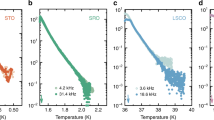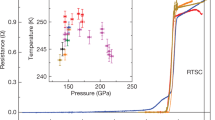Abstract
BEFORE the discovery of the isotope effect in the superconductivity of mercury1,2, it was generally assumed that the variation in the atomic weight (M) of a substance would not influence its transition temperature (Tc). This assumption was based on measurements by Onnes and Tuyn3, and Justi4, who had compared the transition temperatures of uranium lead and ordinary lead, and had found them to be identical. Observations of isotope shifts in the transition temperature of tin5–7, and their agreement with the general theory of Fröhlich8, make it probable that such an effect should also exist in lead. Assuming the validity of Fröhlich's formula Tc ∝1/M1/2, the isotope shift in lead would be of the order of 0.025° K. This difference will have just escaped notice with the resolution used by Onnes and Tuyn, but could have been observed by Justi, who claimed an accuracy of temperature measurements to within several 1/1,000° K.
This is a preview of subscription content, access via your institution
Access options
Subscribe to this journal
Receive 51 print issues and online access
$199.00 per year
only $3.90 per issue
Buy this article
- Purchase on Springer Link
- Instant access to full article PDF
Prices may be subject to local taxes which are calculated during checkout
Similar content being viewed by others
References
Maxwell, E., Phys. Rev., 78, 477 (1950).
Serin, B., Reynolds, C. A., and Nesbitt, L. B., Phys. Rev., 78, 487 (1950).
Onnes, H. K., and Tuyn, W., Comm. Kamerlingh Onnes Lab., Leyden, 106 b (1922).
Justi, E., Phys. Z., 42, 325 (1941).
Maxwell, E., Phys. Rev., 79, 173 (1950).
Lock, J. M., Pippard, A. B., and Shoenberg, D., Nature, 166, 1071 (1950).
Bär, M., Mendelssohn, K., and Olsen, J. L., Nature, 166, 1071 (1950).
Fröhlich, H., Proc. Phys. Soc., A, 63, 778 (1950); Phys. Rev., 79, 845 (1950).
MacDonald, D. K. C., and Mendelssohn, K., Proc. Roy. Soc., A, 200, 66 (1949); 202, 103 (1950).
Soddy, F., Ann. Rep. Chem. Soc., 13, 247, 272 (1916).
Author information
Authors and Affiliations
Rights and permissions
About this article
Cite this article
OLSEN, M. Superconductivity of Lead Isotopes. Nature 168, 245–246 (1951). https://doi.org/10.1038/168245a0
Issue Date:
DOI: https://doi.org/10.1038/168245a0
This article is cited by
-
Neuere experimentelle Ergebnisse aus dem Gebiet der Supraleitung
Die Naturwissenschaften (1955)
Comments
By submitting a comment you agree to abide by our Terms and Community Guidelines. If you find something abusive or that does not comply with our terms or guidelines please flag it as inappropriate.



